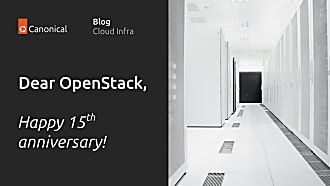Dustin Kirkland
on 12 August 2015
 Canonical is delighted to sponsor ContainerCon 2015, a Linux Foundation event in Seattle next week, August 17-19, 2015. It’s quite exciting to see the A-list of sponsors, many of them newcomers to this particular technology, teaming with energy around containers.
Canonical is delighted to sponsor ContainerCon 2015, a Linux Foundation event in Seattle next week, August 17-19, 2015. It’s quite exciting to see the A-list of sponsors, many of them newcomers to this particular technology, teaming with energy around containers.
From chroots to BSD Jails and Solaris Zones, the concepts behind containers were established decades ago, and in fact traverse the spectrum of server operating systems. At Canonical, we’ve been working on containers in Ubuntu for more than half a decade, providing a home and resources for stewardship and maintenance of the upstream Linux Containers (LXC) project since 2010.
Last year, we publicly shared our designs for LXD — a new stratum on top of LXC that endows the advantages of a traditional hypervisor into the faster, more efficient world of containers.
Those designs are now reality, with the open source Golang code readily available on Github, and Ubuntu packages available in a PPA for all supported releases of Ubuntu, and already in the Ubuntu 15.10 beta development tree. With ease, you can launch your first LXD containers in seconds, following this simple guide.
LXD is a persistent daemon that provides a clean RESTful interface to manage (start, stop, clone, migrate, etc.) any of the containers on a given host.
Hosts running LXD are handily federated into clusters of container hypervisors, and can work as Nova Compute nodes in OpenStack, for example, delivering Infrastructure-as-a-Service cloud technology at lower costs and greater speeds.
Here, LXD and Docker are quite complementary technologies. LXD furnishes a dynamic platform for “system containers” — containers that behave like physical or virtual machines, supplying all of the functionality of a full operating system (minus the kernel, which is shared with the host). Such “machine containers” are the core of IaaS clouds, where users focus on instances with compute, storage, and networking that behave like traditional datacenter hardware.
LXD runs perfectly well along with Docker, which supplies a framework for “application containers” — containers that enclose individual processes that often relate to one another as pools of micro services and deliver complex web applications.
Moreover, the Zen of LXD is the fact that the underlying container implementation is actually decoupled from the RESTful API that drives LXD functionality. We are most excited to discuss next week at ContainerCon our work with Microsoft around the LXD RESTful API, as a cross-platform container management layer.
Ben Armstrong, a Principal Program Manager Lead at Microsoft on the core virtualization and container technologies, has this to say:
As Microsoft is working to bring Windows Server Containers to the world – we are excited to see all the innovation happening across the industry, and have been collaborating with many projects to encourage and foster this environment. Canonical’s LXD project is providing a new way for people to look at and interact with container technologies. Utilizing ‘system containers’ to bring the advantages of container technology to the core of your cloud infrastructure is a great concept. We are looking forward to seeing the results of our engagement with Canonical in this space.
Finally, if you’re in Seattle next week, we hope you’ll join us for the technical sessions we’re leading at ContainerCon 2015, including: “Putting the D in LXD: Migration of Linux Containers”, “Container Security – Past, Present, and Future”, and “Large Scale Container Management with LXD and OpenStack”. Details are below.
Date: Monday, August 17 • 2:20pm – 3:10pm
Title: Large Scale Container Management with LXD and OpenStack
Speaker: Stéphane Graber
Abstract: http://sched.co/3YK6
Location: Grand Ballroom B
Schedule: http://sched.co/3YK6
Date: Wednesday, August 19 10:25am-11:15am
Title: Putting the D in LXD: Migration of Linux Containers
Speaker: Tycho Andersen
Abstract: http://sched.co/3YTz
Location: Willow A
Schedule: http://sched.co/3YTz
Date: Wednesday, August 19 • 3:00pm – 3:50pm
Title: Container Security – Past, Present and Future
Speaker: Serge Hallyn
Abstract: http://sched.co/3YTl
Location: Ravenna
Schedule: http://sched.co/3YTl



